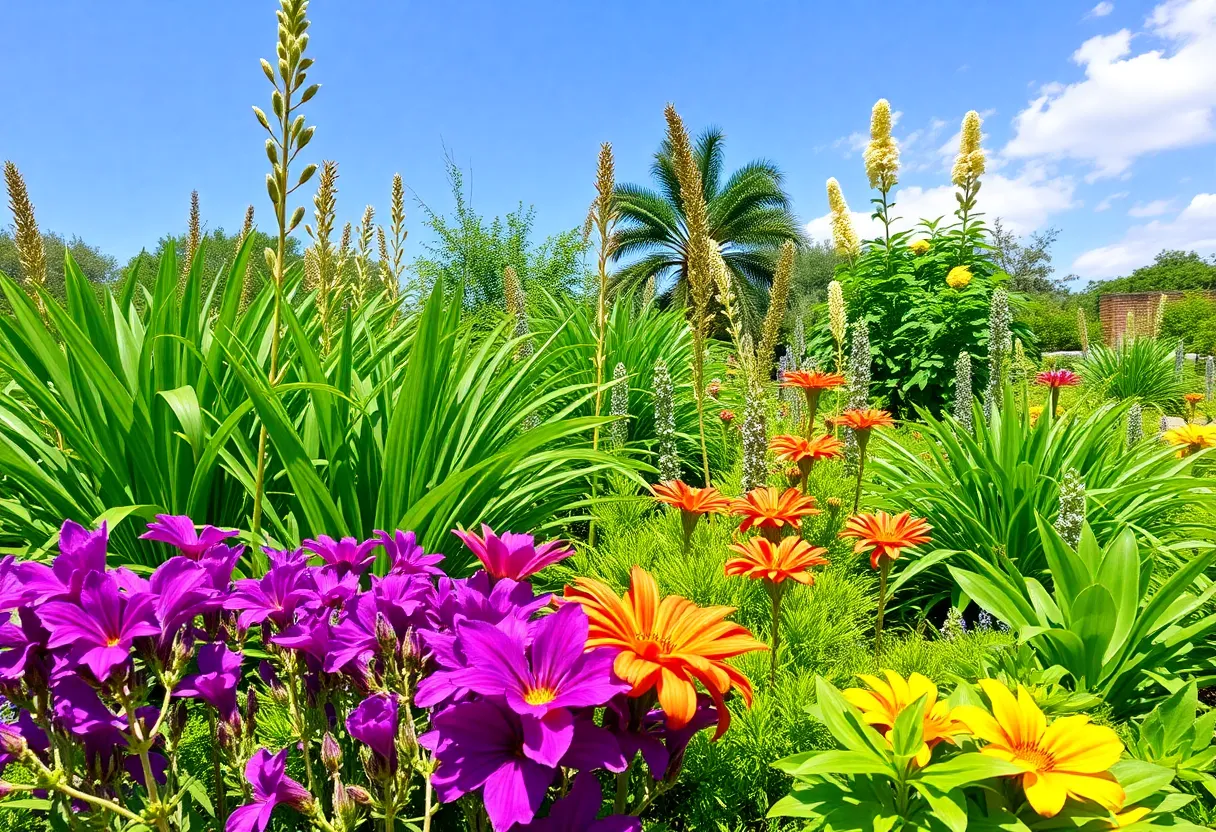Creating a drought-resistant garden in Houston’s climate
Introduction
Creating a drought-resistant garden is an essential step toward water conservation and maintaining plant vitality during Houston’s dry periods. The city’s unique climate challenges—marked by hot, humid summers and periodic droughts—demand careful planning, strategic plant selection, and sustainable horticultural practices. This guide provides comprehensive insights into designing and maintaining a resilient garden suited for Houston’s environment, ensuring long-term plant health while conserving water resources.
Understanding Houston’s Climate
Houston’s climate is characterized by a humid subtropical environment. Summers often see temperatures exceeding 90°F (32°C), coupled with high humidity levels. These conditions create significant stress on plants not adapted specifically for such environments.
While rainfall is abundant during spring and early summer, late summer and fall often bring reduced precipitation. These dry spells can lead to drought conditions, impacting both natural landscapes and ornamental gardens. Given this variability, selecting plants with inherent drought tolerance becomes vital.
Understanding the implications of Houston’s climate allows gardeners to choose appropriate strategies, including plant selection and irrigation planning, that enhance resilience in their gardens.
Key Principles for a Drought-Resistant Garden
1. Strategic Plant Selection
Choosing native and drought-tolerant plants is the cornerstone of a sustainable Houston garden. These species have naturally adapted to local soil, climate, and moisture conditions, requiring less supplemental watering once established.
Such plants typically develop deeper root systems, enabling them to access underground water sources and thrive with minimal irrigation. Selecting appropriate species minimizes maintenance and maximizes water efficiency.
2. Soil Preparation
Healthy, well-prepared soil improves water retention and enhances plant growth. Incorporate organic matter, like compost, into native soil. This enhances soil structure, increases water-holding capacity, and promotes healthy root development.
Proper soil preparation creates an optimal environment for drought-tolerant plants, ensuring they establish quickly and remain resilient during dry spells.
3. Mulching
Applying a 2-3 inch layer of organic mulch around plants offers multiple benefits:
- Moisture Retention: Mulch reduces evaporation from the soil surface.
- Weed Suppression: Keeps weeds from competing for water and nutrients.
- Temperature Regulation: Maintains consistent soil temperature, reducing stress on roots.
Regular replenishment of mulch ensures these benefits persist over time.
Optimal Plant Choices for Houston
Texas Sage (Leucophyllum frutescens)
This shrub offers striking silvery-gray foliage and vibrant purple blooms. It thrives in full sun, well-drained soil, and minimal water after establishment. Its resilience to drought conditions makes it a popular choice.
Texas Lantana (Lantana urticoides)
Known for its vivid orange to red flowers, Texas Lantana attracts pollinators such as butterflies and hummingbirds. It tolerates poor soils and provides continuous color from spring through fall with minimal watering.
Eastern Purple Coneflower (Echinacea purpurea)
This perennial produces large, colorful daisies loved by pollinators. It grows best in full sun with well-drained soil and requires infrequent watering, making it ideal for xeriscaping.
Autumn Sage (Salvia greggii)
Blooming from late spring to frost, Autumn Sage attracts hummingbirds and tolerates a range of soil conditions. Its ability to thrive with limited irrigation enhances overall drought resilience.
Gulf Coast Muhly (Muhlenbergia capillaris)
An ornamental grass known for its feathery pink plumes in fall, Gulf Coast Muhly adds texture. It is water-efficient, preferring full to partial sun and well-drained soils.
Watering Strategies for a Drought-Resistant Garden
Deep Watering
Focus on watering deeply and infrequently. Deep watering encourages roots to grow downward, fostering drought-resistant plants capable of weathering dry periods better.
Timing
Water early in the morning or late in the evening. This reduces water loss through evaporation, maximizing effectiveness.
Drip Irrigation
Employ drip irrigation systems for precise watering, delivering water directly to roots. This minimizes waste and enhances efficiency, especially around native and drought-tolerant plants.
Maintenance and Seasonal Adjustments
Pruning
Regularly prune dead or diseased foliage. Proper pruning improves airflow and plant vigor, reducing susceptibility to pests and disease.
Pest and Disease Monitoring
Assess plants routinely for pests or signs of disease. Prompt intervention helps maintain plant health and reduces the need for water-intensive treatments.
Seasonal Care
Adjust watering and fertilization routines based on seasonal weather patterns and plant growth cycles. Recognizing when plants require additional support ensures their resilience.
Additional Tips for a Drought-Resistant Houston Garden
- Group Plants by Water Needs: Plant species with similar watering requirements together to optimize irrigation efficiency.
- Use Native Plants: Prioritize native flora, which naturally withstand Houston’s climate with less water.
- Install Ground Covers: Use low-growing perennials like creeping thyme or lamb’s ear to suppress weeds, reduce soil erosion, and retain moisture.
- Avoid Overwatering: Monitor soil moisture levels regularly to prevent over-irrigation, which can promote disease and waste water.
Conclusion
Implementing a drought-resistant garden tailored for Houston’s climate hinges on thoughtful plant choices, soil health, and water management. By incorporating native and drought-tolerant plants, preparing soil effectively, and applying efficient watering practices, homeowners can develop landscapes that endure dry periods with minimal water use. Such gardens not only contribute to water conservation efforts but also promote sustainable urban horticulture, maintaining vibrant, healthy landscapes year-round.
Frequently Asked Questions
What are the best native plants for a drought-resistant garden in Houston?
Native plants such as Texas Sage, Eastern Purple Coneflower, and Gulf Coast Muhly are highly adapted to Houston’s climate. They require less water, are resilient to drought, and attract pollinators.
How often should I water my drought-tolerant plants?
Once established, most drought-tolerant plants only need deep watering once every 2-3 weeks, depending on rainfall and soil conditions. Early morning or late evening watering reduces evaporation.
What soil amendments work best for Houston’s climate?
Adding organic matter like compost significantly enhances water retention and soil fertility, creating an ideal medium for drought-resistant plants.
How can I reduce water runoff and ensure efficient irrigation?
Use drip irrigation or soaker hoses targeted at the plant roots. Group plants with similar water needs, and apply mulch to retain soil moisture.
Are there any specific plants I should avoid in Houston’s drought-prone areas?
Avoid plants that require high water levels or are non-native, such as traditional turf grasses, unless specific water-saving measures are implemented.
Key Features Chart
| Feature | Description |
|---|---|
| Climate Compatibility | Plants native or adapted to Houston’s humid subtropical climate, tolerant to heat and drought. |
| Water Needs | Low to moderate; prefers deep, infrequent watering once established. |
| Soil Preferences | Well-drained soils, amended with compost to improve water retention. |
| Maintenance Requirements | Minimal pruning, pest monitoring, and seasonal adjustments. |
| Attracts Pollinators | Many species attract butterflies, hummingbirds, and bees, supporting local ecosystems. |
Author: STAFF HERE HOUSTON TX WRITER
The HOUSTON STAFF WRITER represents the experienced team at HEREHouston.com, your go-to source for actionable local news and information in Houston, Harris County, and beyond. Specializing in "news you can use," we cover essential topics like product reviews for personal and business needs, local business directories, politics, real estate trends, neighborhood insights, and state news affecting the area—with deep expertise drawn from years of dedicated reporting and strong community input, including local press releases and business updates. We deliver top reporting on high-value events such as Houston Livestock Show and Rodeo, Art Car Parade, and Chevron Houston Marathon. Our coverage extends to key organizations like the Greater Houston Partnership and Houston Area Urban League, plus leading businesses in energy and healthcare that power the local economy such as ExxonMobil, Schlumberger, and Houston Methodist. As part of the broader HERE network, including HEREAustinTX.com, HERECollegeStation.com, HEREDallas.com, and HERESanAntonio.com, we provide comprehensive, credible insights into Texas's dynamic landscape.





